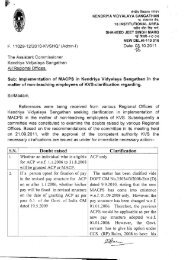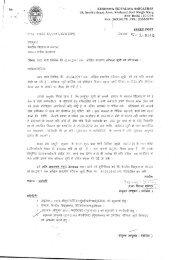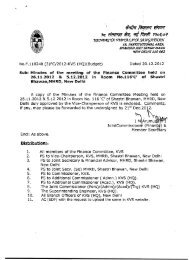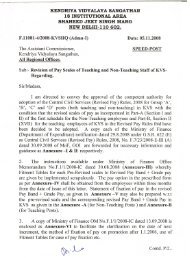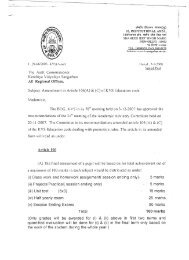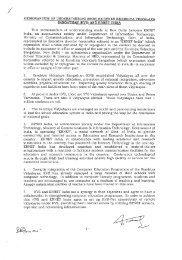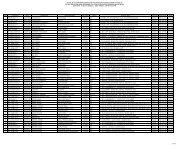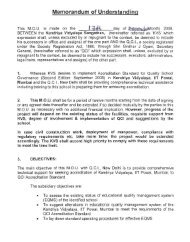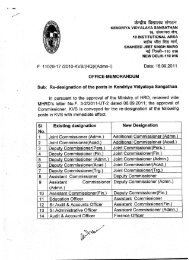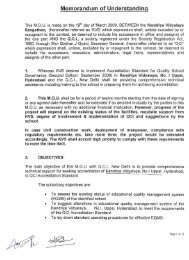<strong>Syllabus</strong> <strong>for</strong> <strong>written</strong> <strong>examination</strong> <strong>for</strong> <strong>PGT</strong> (Computer Science)COMPUTER SYSTEMS ARCHITECTURE1. THE COMPUTER SYSTEMSystem buses: Computer Components, Computer function, InterconnectionStructures, Bus Interconnection, PCI.Internal Memory: Computer Memory System Overview, Semiconductor Main Memory,Cache Memory, Advanced DRAM Organization.Input/ Output: External Devices, I/O Modules, Programmed I/O, Interrupt- Driven I/O,Direct Memory Access, I/O Channels and Producers, The External Interface.Operating System Overview.2. THE CENTRAL PROCESSING UNITComputer Arithmetic: The Arithmetic and Logic Unit (ALU), Integer Arithmetic,Floating-Point Representation, Floating-Point Arithmetic.Instruction Sets: Characteristics and Function, Machine Instruction Characteristics,Types of Operands, Types of Operation, Addressing Modes and Formats, RegisterOrganization, The Instruction Cycle, Instruction Pipelining.Assembly LanguageThe Control Unit: Micro-operations, control of the CPU, hardwired Implementation,Micro program Controller, Basic Concepts, Microinstructions, Sequencing,Microinstruction Execution.Reduced Instruction Set Computer: An Introduction.OPERATING SYSTEMSIntroduction: System software, resource abstraction, OS strategies; multiprogramming,batch, time sharing, personal computers and workstation, process control & real timesystems, processes & threads using FORK, JOIN, QUIT.Operating System Organization: Factors in operating system design, basic OSfunction, implementation consideration: process modes, kernels, methods ofrequesting system services, device drivers.Device Management: Service management approaches, buffering, device drivers,per<strong>for</strong>mance tuning.Process Management: System view of the process and resources, initiating The OS,process address space, process abstraction, resource abstraction, process hierarchy.Scheduling: Scheduling Mechanisms, Strategy selection, non-pre-emptive and preemptivestrategies.Synchronization Principles: Interactive processes, critical section, deadlock,coordinating processes, semaphores, spread memory, multiprocessors, events,monitors and the inter-process communication.Deadlocks: System deadlock model, prevention strategies, hold and wait, circular wait,allowing pre-emption, Banker’s Algorithm, serially reusable resources, consumableresources, general resources system recovery.Memory Management: Mapping address space to memory space, memory allocationstrategies, fixed partition, variable partition, segmentation.File Management: Directory structure, basic file operations and their implementation.Protection and Security: Policy mechanism, authentication, internal accessauthorization.DIGITAL ELECTRONICSFundamental Concepts: Digital signal, NAND, NOR and Exclusive-OR operation, BooleanAlgebra, Basic Digital Circuits.Number system and Codes: Primary, Octal, Hexadecimal, Signed Numbers Codes,hamming codes.Combinational Logic Design: K-map representation of logical functions and simplificationusing K-map of 4 and 5 variables, Quine- McCluskey’s method.Multiplexers, Demultiplexers, Adders and Subtracters, multipliers, Comparators, Paritygenerators and checkers, Code converters, Priority Encoders, Decoders.
Races, hazards, and asynchronous behaviorFlip-Flops: Clocked RS flip flop, D-type flip flop, Excitation table of flip flop, Edge triggeredflip flop, Clocked flip flop design.Sequential Logic Designs: Registers, Shift registers, Asynchronous counters, synchronouscounters, RAM, ROM.PROGRAMMING FUNDAMENTALSBasic Computer Organization: Functional Units, basic I/O devices and storage devices;Representation of integers, real (fixed and floating point), characters (ASCII and Unicode);Basic operations of a programming environment.Problem Solving Approaches: Notion of an algorithm, problem solving using top-downdesign and decomposition into sub-problems, stepwise methodology of developing analgorithm, methodology of developing an algorithmic solution from a mathematicalspecification of the problem, use of recursion <strong>for</strong> problems with inductive characterization.Programming using a modern programming language such as Java, emphasizing thefollowing notions: Building blocks: arithmetic and logical expression, variables,assignment; Specifying the input-output interface (type); control structures includingsequencing, conditionals, loops, procedural abstractions (procedures, methods); basicdata structures-integers, reals, strings and arrays-and internal representation of scalarand vector data; data abstraction and encapsulation-objects, classes and packages; input/output of data.Numerical and non-numerical applications using above concepts.PROGRAMMING TOOL: VISUAL BASICIntroduction to Programming –Modular Programming, Object Oriented Programming,Event Driven Programming:About Visual Basic (Object Based Programming Language), Rapid Application Developmentusing Visual Basic;Concept of Project In Visual Basic, VB Project Options- Standard EXE, ActiveX DLL, ActiveXEXE, ActiveX Control, Active X Document EXE, Addin, VB Application Wizard, IISApplication, DHTML Application;Getting Familiar with Visual Basic User Interface-Pull-Down menus, Toolbar, Toolbox,Project Explorer, Properties Window, Form Layout Window, Form, Immediate window;Opening and Closing window, Resizing and moving windows, Docking windows; QuittingVisual Basic;Visual Basic Tool Box (Standard Window Controls)- Pointer, Picture Box, Lbel, Text Box,Frame, Command Button, Check Box, Option Button, Combo Box, List Box, HorizontalScrollbar, Vertical Scrollbar, Timer, Drive List box, Directory List box, File List Box, Shape,Line, Image, Data, OLE;Object Naming Conventions, Event Procedures;Data Types: Integer, Long, Single, Double, Currency, String, Byte, Boolean, Date, Object,Variant;Variables: Need to use variable, Declaring Variables, Variable Naming Convention,Assigning value to Variables, Data Types of variable, Scope and lifetime of Variables(Public and Private);Menu Editor : Concept of menus, Shortcut menus and Popup menus Designing MenuSystem, Menu Editor Dialog Box Options (Name, Index, Shortcut, Help Context ID,Negotiate Position, Checked, Enabled, Visible, Window List, Right Arrow, Left Arrow, UpArrow, Down Arrow, Menu List, Next, Insert, Delete, OK, Cancel), To Create Menu Controlsin the Menu Editor, Menu Naming Conventions, Setting the Name Property, Creating aMenu Control Array, Creating Sub Menus, Separating Menu Controls, Assigning AccessKeys and Shortcut Keys, Controlling Menus at Runtime-Enabling and Disabling MenuCommands, Displaying a Checkmark on a Menu Control, Making a Menu Control Invisible,Adding Menu Control at Runtime, Displaying Pop-Up Menu;General Controls (Advance): Image List, Common Dialog Box, ADO DC, DB Combo, MediaPlayer Control, DB Grid;Adding a Toolbar: Creating an Image List, Adding Images to the Toolbar, To Add Code <strong>for</strong>the Toolbar Buttons;Adding Status Bar: Adding Status Bar panels, Adding Time on the panel.Dialog Boxes: Pre-defined dialog box, Custom dialog box;DATA STRUCTURESIntroduction to the object-based and object-oriental programming paradigms; records,abstract data types and objects, data abstraction and internal representation;programming-in-the-large issues: modularity and code re-usability, classes and packages;graphical user interfaces; command-line arguments; interfacing with libraries and separatecompilation; language support and OOP: Sub-typing, Inheritance, classes and subclasses,header files, function templates, overloading.



